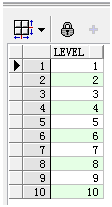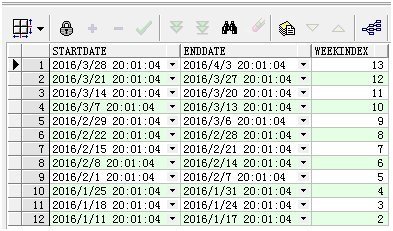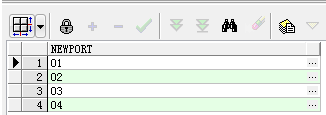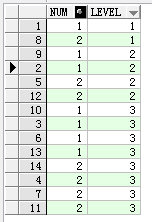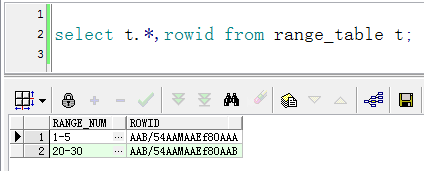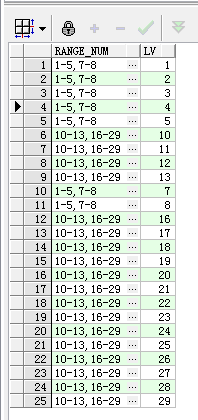oracle connect by用法篇
1、基本語法
select * from table [start with condition1]
connect by [prior] id=parentid一般用來查詢存在父子關係的資料,也就是樹形結構的資料;其返還的資料也能夠明確的區分出每一層的資料。
start with condition1 是用來限制第一層的資料,或者叫根節點資料;以這部分資料為基礎來查詢第二層資料,然後以第二層資料查詢第三層資料以此類推。
connect by [prior] id=parentid 這部分是用來指明oracle在查詢資料時以怎樣的一種關係去查詢;比如說查詢第二層的資料時用第一層資料的id
去跟表裡面記錄的parentid欄位進行匹配,如果這個條件成立那麼查找出來的資料就是第二層資料,同理查詢第三層第四層…等等都是按這樣去匹配。
prior還有一種用法:
select * from table [start with condition1]
connect by id= [prior] parentid- 這種用法就表示從下往上查詢資料,可以理解為從葉子節點往上查詢父級幾點,用第一層資料的parentid去跟表記錄裡面的id進行匹配,匹配成功那麼查找出來的就是第二層資料;上面的那種就是從父級節點往下查詢葉子節點。
其他特性
- level關鍵字,代表樹形結構中的層級編號;第一層是數字1,第二層數字2,依次遞增。
- CONNECT_BY_ROOT方法,能夠獲取第一層集結點結果集中的任意欄位的值;例CONNECT_BY_ROOT(欄位名)。
2、下面來貼兩個例子
2.1 從根節點查詢葉子節點
select t.*, level, CONNECT_BY_ROOT(id)
from tab_test t
start with t.id = 0
connect by prior t.id = t.fid;2.2 從葉子節點查詢上層節點
--第一種,修改prior關鍵字位置
select t.*, level, CONNECT_BY_ROOT(id)
from tab_test t
start 3、寫幾個平常用到的其他一些用法
3.1 生成數字序列結果集
- 使用rownum實現1到10的序列。
select rownum from dual connect by rownum<=10;結果集如下:
- 使用level實現1到10的序列。
select level from dual connect by level<=10;結果集如下:
3.2 查詢當前時間往前的12周的開始時間、結束時間、第多少周
select sysdate - (to_number(to_char(sysdate - 1, 'd')) - 1) -
(rownum - 1) * 7 as startDate,
sysdate + (7 - to_number(to_char(sysdate - 1, 'd'))) -
(rownum - 1) * 7 as endDate,
to_number(to_char(sysdate, 'iw')) - rownum + 1 as weekIndex
from dual
connect by level<= 12;--將level改成rownum可以實現同樣的效果- d 表示一星期中的第幾天
- iw 表示一年中的第幾周
3.3 字串分割,由一行變為多行
- 比如說分割01#02#03#04這種有規律的字串
select REGEXP_SUBSTR('01#02#03#04', '[^#]+', 1, rownum) as newport
from dual connect by rownum <= REGEXP_COUNT('01#02#03#04', '[^#]+');4、省略prior關鍵字時資料的返回策略
構造一個結果集,其中包含兩條資料;然後查詢level為1,2,3層的資料。
select t.*, level
from (select 1 as num from dual
union
select 2 as num from dual
) t
connect by level <= 3;從上面截圖的結果可以看出來省略prior關鍵字時第1層的資料就是初始結果集,第2層的資料是初始結果集的兩倍,第3層的資料是初始結果集的3倍;假設初始結果集的記錄為n條,查詢m層的記錄,則返回的記錄數就是:
條記錄。
在省略prior關鍵字對資料進行操作時需要特別注意,返回的資料不一定是你所期望的那樣。
5、下面再看看幾個例子,針對多條結果集當省略prior關鍵字時怎樣獲得正確的返回結果
5.1 有下面一個結果集
想要實現1-5,20-30的資料遞增返回1、2、3、4、5、20、21、22、23、24、25、26、27、28、29、30總共16條記錄。
SQL如下:
with temp0 as (
select t.range_num,
REGEXP_SUBSTR(t.range_num, '[^-]+', 1, 1) minNum, --最小num
REGEXP_SUBSTR(t.range_num, '[^-]+', 1, 2) maxNum --最大num
from range_table t
)
select t1.range_num ,t2.lv
from temp0 t1 join (
select level lv from dual
CONNECT BY LEVEL <= (select max(maxNum) from temp0 )
) t2
on (t2.lv >=t1.minNum and t2.lv <=t1.maxNum);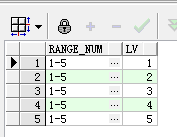
上面的sql中是先求出range_num的最大值與最小值,然後利用connect by 特性生成數值序列結果集,最後讓兩個結果集關聯得到需要的結果。
5.2 再看稍微複雜的結果集,輸出結果格式跟上面一樣
SQL如下:
with temp0 as (
select b.range_num,
REGEXP_SUBSTR(b.range_num, '[^,]+', 1, c.lv) as newport,
REGEXP_SUBSTR(REGEXP_SUBSTR(b.range_num, '[^,]+', 1, c.lv), '[^-]+', 1, 1) as minNum,
REGEXP_SUBSTR(REGEXP_SUBSTR(b.range_num, '[^,]+', 1, c.lv), '[^-]+', 1, 2) as maxNum
from (select regexp_count(a.range_num, '[^,]+') AS cnt,
range_num
from range_table a) b
join (select LEVEL lv from dual CONNECT BY LEVEL <= 50) c
--這裡的50表示的是range_num通過,分割後的數量,這裡寫死了50也可以sql動態max出來
on c.lv <= b.cnt
)
select t1.range_num,t2.lv
from temp0 t1
join (
select level lv from dual
CONNECT BY LEVEL <= (
select max(to_number(maxNum)) from temp0
)
) t2
on ((t2.lv >=t1.minNum and t2.lv <=t1.maxNum));



